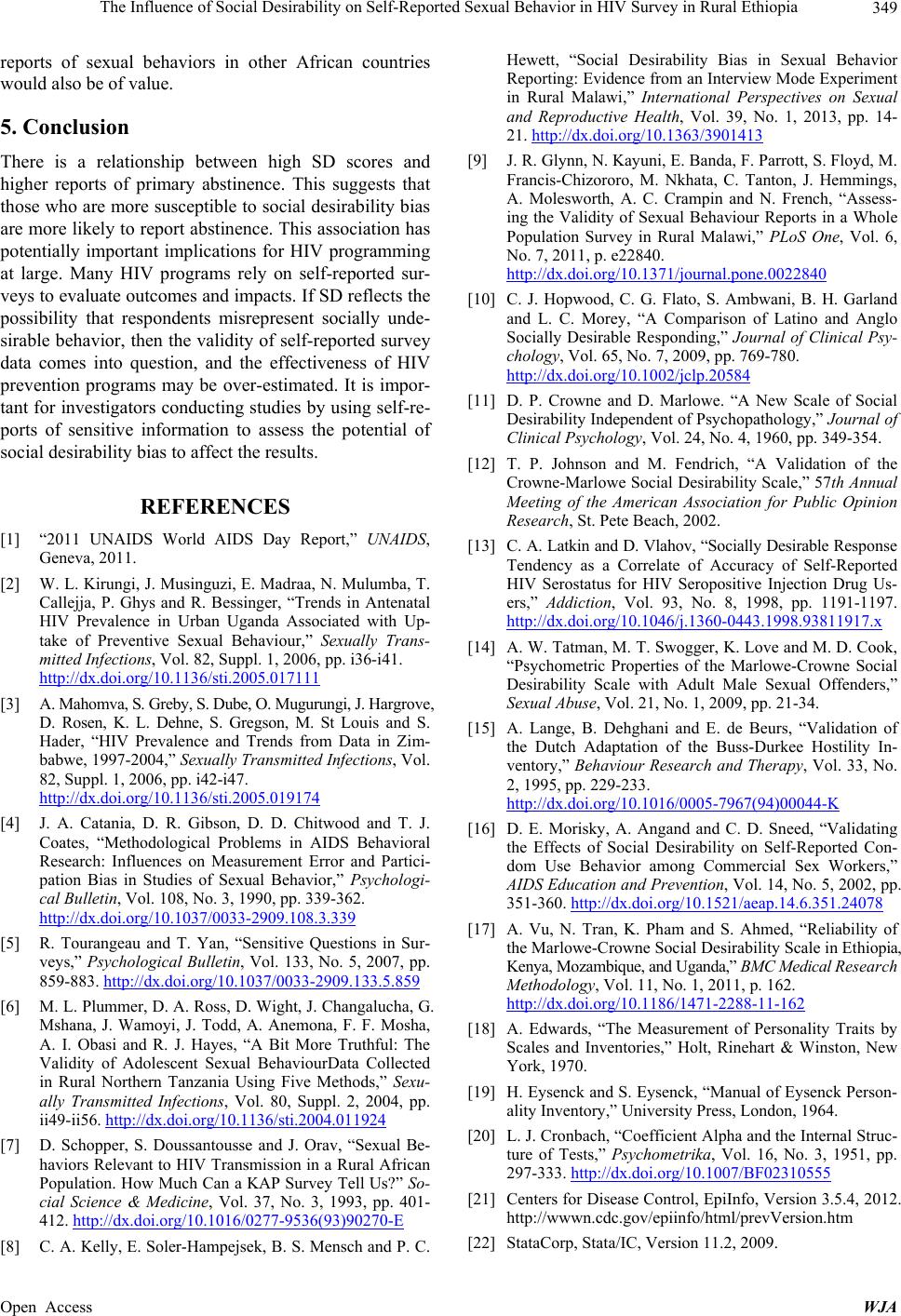
The Influence of Social Desirability on Self-Reported Sexual Behavior in HIV Survey in Rural Ethiopia
Open Access WJA
349
reports of sexual behaviors in other African countries
would also be of value.
5. Conclusion
There is a relationship between high SD scores and
higher reports of primary abstinence. This suggests that
those who are more susceptible to social desirability bias
are more likely to report abstinence. This association has
potentially important implications for HIV programming
at large. Many HIV programs rely on self-reported sur-
veys to evaluate outcomes and impacts. If SD reflects the
possibility that respondents misrepresent socially unde-
sirable behavior, then the validity of self-reported survey
data comes into question, and the effectiveness of HIV
prevention programs may be over-estimated. It is impor-
tant for investigators conducting studies by using self-re-
ports of sensitive information to assess the potential of
social desirability bias to affect the results.
REFERENCES
[1] “2011 UNAIDS World AIDS Day Report,” UNAIDS,
Geneva, 2011.
[2] W. L. Kirungi, J. Musinguzi, E. Madraa, N. Mulumba, T.
Callejja, P. Ghys and R. Bessinger, “Trends in Antenatal
HIV Prevalence in Urban Uganda Associated with Up-
take of Preventive Sexual Behaviour,” Sexually Trans-
mitted Infections, Vol. 82, Suppl. 1, 2006, pp. i36-i41.
http://dx.doi.org/10.1136/sti.2005.017111
[3] A. Mahomva, S. Greb y, S . Dub e, O. Mugur ungi, J . Hargrove,
D. Rosen, K. L. Dehne, S. Gregson, M. St Louis and S.
Hader, “HIV Prevalence and Trends from Data in Zim-
babwe, 1997-2004,” Sexually Transmitted Infections, Vol.
82, Suppl. 1, 2006, pp. i42-i47.
http://dx.doi.org/10.1136/sti.2005.019174
[4] J. A. Catania, D. R. Gibson, D. D. Chitwood and T. J.
Coates, “Methodological Problems in AIDS Behavioral
Research: Influences on Measurement Error and Partici-
pation Bias in Studies of Sexual Behavior,” Psychologi-
cal Bulletin, Vol. 108, No. 3, 1990, pp. 339-362.
http://dx.doi.org/10.1037/0033-2909.108.3.339
[5] R. Tourangeau and T. Yan, “Sensitive Questions in Sur-
veys,” Psychological Bulletin, Vol. 133, No. 5, 2007, pp.
859-883. http://dx.doi.org/10.1037/0033-2909.133.5.859
[6] M. L. Plummer, D. A. Ross, D. Wight, J. Changalucha, G.
Mshana, J. Wamoyi, J. Todd, A. Anemona, F. F. Mosha,
A. I. Obasi and R. J. Hayes, “A Bit More Truthful: The
Validity of Adolescent Sexual BehaviourData Collected
in Rural Northern Tanzania Using Five Methods,” Sexu-
ally Transmitted Infections, Vol. 80, Suppl. 2, 2004, pp.
ii49-ii56. http://dx.doi.org/10.1136/sti.2004.011924
[7] D. Schopper, S. Doussantousse and J. Orav, “Sexual Be-
haviors Relevant to HIV Transmission in a Rural African
Population. How Much Can a KAP Survey Tell Us?” So-
cial Science & Medicine, Vol. 37, No. 3, 1993, pp. 401-
412. http://dx.doi.org/10.1016/0277-9536(93)90270-E
[8] C. A. Kelly, E. Soler-Hampejsek, B. S. Mensch and P. C.
Hewett, “Social Desirability Bias in Sexual Behavior
Reporting: Evidence from an Interview Mode Experiment
in Rural Malawi,” International Perspectives on Sexual
and Reproductive Health, Vol. 39, No. 1, 2013, pp. 14-
21. http://dx.doi.org/10.1363/3901413
[9] J. R. Glynn, N. Kayuni, E. Banda , F. Parrott, S. Floyd, M.
Francis-Chizororo, M. Nkhata, C. Tanton, J. Hemmings,
A. Molesworth, A. C. Crampin and N. French, “Assess-
ing the Validity of Sexual Behaviour Reports in a Whole
Population Survey in Rural Malawi,” PLoS One, Vol. 6,
No. 7, 2011, p. e22840.
http://dx.doi.org/10.1371/journal.pone.0022840
[10] C. J. Hopwood, C. G. Flato, S. Ambwani, B. H. Garland
and L. C. Morey, “A Comparison of Latino and Anglo
Socially Desirable Responding,” Journal of Clinical Psy-
chology, Vol. 65, No. 7, 2009, pp. 769-780.
http://dx.doi.org/10.1002/jclp.20584
[11] D. P. Crowne and D. Marlowe. “A New Scale of Social
Desirability Independent of Psychopathology,” Journal of
Clinical Psychology, Vol. 24, No. 4, 1960, pp. 349-354.
[12] T. P. Johnson and M. Fendrich, “A Validation of the
Crowne-Marlowe Social Desirability Scale,” 57th Annual
Meeting of the American Association for Public Opinion
Research, St. Pete Beach, 2002.
[13] C. A. Latkin and D. Vlahov, “Socially Desirable Response
Tendency as a Correlate of Accuracy of Self-Reported
HIV Serostatus for HIV Seropositive Injection Drug Us-
ers,” Addiction, Vol. 93, No. 8, 1998, pp. 1191-1197.
http://dx.doi.org/10.1046/j.1360-0443.1998.93811917.x
[14] A. W. Tatman, M. T. Swogger, K. Love and M. D. Cook,
“Psychometric Properties of the Marlowe-Crowne Social
Desirability Scale with Adult Male Sexual Offenders,”
Sexual Abuse, Vol. 21, No. 1, 2009, pp. 21-34.
[15] A. Lange, B. Dehghani and E. de Beurs, “Validation of
the Dutch Adaptation of the Buss-Durkee Hostility In-
ventory,” Behaviour Research and Therapy, Vol. 33, No.
2, 1995, pp. 229-233.
http://dx.doi.org/10.1016/0005-7967(94)00044-K
[16] D. E. Morisky, A. Angand and C. D. Sneed, “Validating
the Effects of Social Desirability on Self-Reported Con-
dom Use Behavior among Commercial Sex Workers,”
AIDS Education and Prevention, Vol. 14, No. 5, 2002, pp.
351-360. http://dx.doi.org/10.1521/aeap.14.6.351.24078
[17] A. Vu, N. Tran, K. Pham and S. Ahmed, “Reliability of
the Marlowe-Crowne Social Desirability Scale in Ethiopia,
Kenya, Mozambique, and Uganda,” BMC Medical Research
Methodology, Vol. 11, No. 1, 2011, p. 162.
http://dx.doi.org/10.1186/1471-2288-11-162
[18] A. Edwards, “The Measurement of Personality Traits by
Scales and Inventories,” Holt, Rinehart & Winston, New
York, 1970.
[19] H. Eysenc k and S. Eysenck , “Manual of Eysenck Person-
ality Inventory,” University Press, London, 1964.
[20] L. J. Cronbach, “Coefficient Alpha and the Internal Struc-
ture of Tests,” Psychometrika, Vol. 16, No. 3, 1951, pp.
297-333. http://dx.doi.org/10.1007/BF02310555
[21] Centers for Disease Control, EpiInfo, Version 3.5.4, 2012.
http://wwwn.cdc.gov/epiinfo/html/prevVersion.htm
[22] StataCorp, Stata/IC, Version 11.2, 2009.